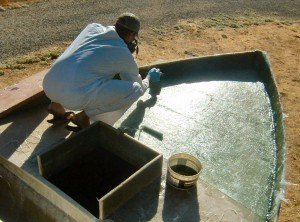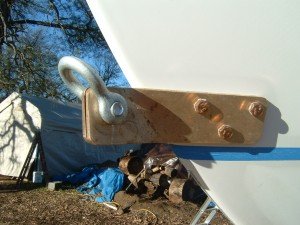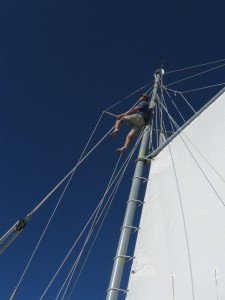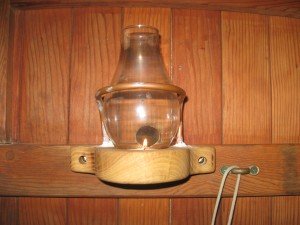
When the inevitable advent of children made us look for a boat bigger than our little 27-foot Capella, we knew that the “Perfect” boat would be very hard to find. We had a very specific style in mind—full keel, heavy displacement, stern-hung-rudder style; the sort designed along the lines of working pilot cutters of a century ago and more. We also wanted to add a lot of our own design ideas: ideas conceived in the long night watches sitting at Capella’s helm, wishing that was just a little different, and this wasn’t quite so in the way. It really seems the best way to design boats to me—rather than sitting on shore in an immobile office, to be out watching all your pots jump their shelf fiddles, spilling your coffee time and again in a bad blow; trying to function while underway for a week and more at a time. It was then that we got most of the ideas we designed into our kit boat Ganymede.

I had always wanted to build a kit boat, and since we would have to live on land for a few years while the children progressed, I figured this might be our only chance. Ganymede’s hull came from the Cape George Marine Works in Port Townsend, Washington. She was designed by William Atkin, who, along with Lyle Hess, I consider to have designed the best small cruising boats ever. Though a factory finished Cape George 31 was going for $395,000 at the time, the hull cost us only $23,000. It was still all we could scrape together, even after three years of working hard and saving, but the day the hull arrived and was finally in our yard was about the most exciting of my life, and worth every penny.

We finished Ganymede, over the next three years, simply and strongly. To prevent rot there is no structural plywood anywhere, but rather foam-cored fiberglass panels I made myself, and we went to great lengths to avoid mounting hardware onto the cabintop and decks where the bolts could eventually leak. After maintaining acres of brightwork on Capella, we decided that varnish is for chumps, and kept all the varnish on the inside, which we finished out in locally available Doug fir and Redwood. One thing that allows us to live and cruise aboard a 31-foot boat with three children is that we maximized inside space by raising the cabin sole past the turn of the bilge, so the walking space is nice and wide, then building a cabintop with six-foot headroom. There is no inboard engine or cockpit well, rather, a cozy aft cabin with seven-foot bunks and lots of storage where the girls and all their posessions live.
Instead of a V-berth, there’s a double bunk lying athwartships just forward of the mast. This eliminates the need for leecloths or for wedging oneself in place in the V-berth when underway, since you can just lie with your head to the high side and not be rolled back and forth. In the forepeak, separated by a watertight bulkead from the cabin, is a vast chain, sail and tool locker. Everything smelly, wet, or dirty goes in there, and doesn’t impinge on the living area, with which there is no communication.

To save money, we did almost all our own work, and fabricated as much hardware as possible. It was a often a test of ingenuity and improvisation, but very rewarding, especially since most of my homemade fittings are still working perfectly three years,7,500 miles, two oceans, and seven countries later.

Perhaps the most conspicuous aspect of our boat is the rig. At first sight the mast appears short, with the spreaders ridiculously high up, and an impossible amount of halyards festooned everywhere. Then to crown it all, there’s a round radar reflector at the very masthead, looking like one of those antenna balls people use to find their cars in parking lots. But there’s good reason for all those things. The radar reflector is mounted at the optimum height for giving a good return, and can’t be blanketed by a sail, like ones dangling from spreaders. The mast is short because the gaff rig we designed carries it’s sail area low, while still spreading 30 square feet more than the jib-headed Cape Georges with masts twelve feet taller! The gaff rig was also easier for me to make at home, out of an aluminum light pole, some bar stock and a few bits of aluminum tubing. All told, the whole gang of rigging (sails excluded) cost about $3,000. A far cry from the $10,000 that a Bermudian setup would have been.
There’s another reason for the gaff rig: in old photographs, boats with this very hull shape are very often seen with gaff-headed sails, and there was always something so romantically nautical about them that I couldn’t resist giving it a try. It has been, so far, an enormous success, so much so that I don’t think I could ever go back to a Bermudian-rigged boat. The gaff rig is powerful and easy to handle (no halyard winches at all!), while not requiring as much tension in the standing rigging, so everything is under less strain.

From the date of arrival to Launching Day was exactly three years and one month. Ganymede doesn’t have all the bells and whistles that some other boats enjoy, but she’s just the thing we wanted, and we have not developed any desire toward extravagant extras like electricity and refrigeration. In fact, the further we cruise, the more uneccesary conveniences we drop. Latest to go: the electric compass light, replaced instead by a tea-light candle inside a lamp chimey, with a copper tube to convey the light through the bulkhead to the compass.